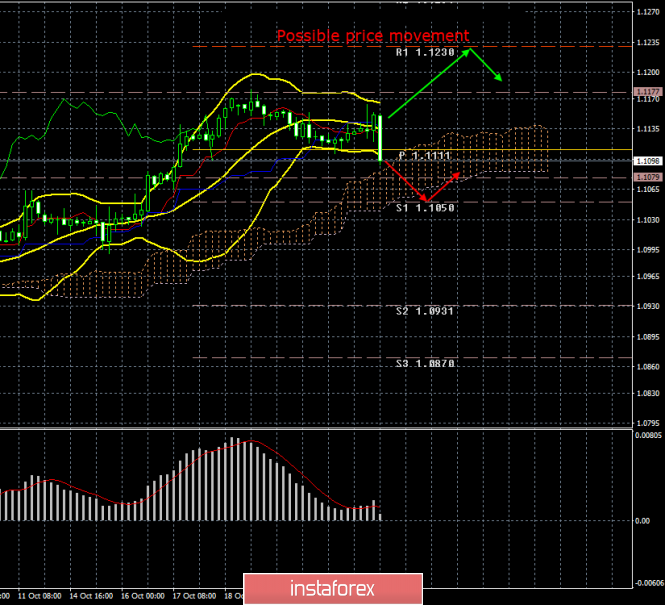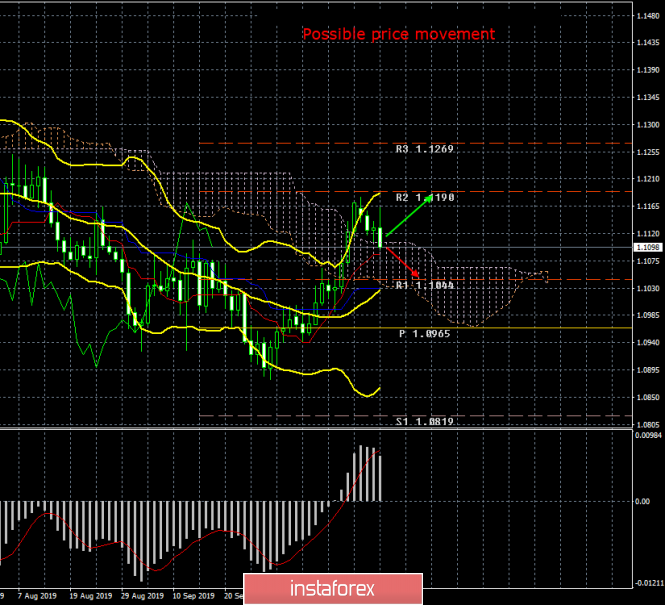4-hour timeframe

Amplitude of the last 5 days (high-low): 75p - 56p - 41p - 39p - 34p.
Average volatility over the past 5 days: 49p (average).
The penultimate trading day of the week was in more active trading than the first three. There is nothing surprising in this, as there were plenty of macroeconomic reports and events today. Below we will consider them in detail. Now we can say that the bears went on the attack, as they received the most compelling reasons for this at the US trading session. Thus, the chances of a resumption of the downward trend have significantly grown on Thursday, and the euro/dollar pair itself has already fallen 65 points from the high of the day.
All the first three days we just did what we wrote about the upcoming ECB meeting, about the whole package of various macroeconomic reports on Thursday. This Thursday has arrived, and there really is something to analyze. It all started with the publication of business activity indexes in Germany and the European Union. Without going into too much detail, we'll immediately say that all six indices turned out to be worse than forecasted values, although five out of six indices showed improvement compared to the previous month. However, this improvement doesn't mean much and certainly does not add optimism to traders, since the most significant and expected business activity indexes in the EU and Germany production again failed miserably, amounting to 45.7 and 41.9. Recall that any value below 50.0 represents an industry decline. Thus, it is easy to guess in what condition the industry of both the "locomotive of the European Union" and the European Union itself is in. On this news, traders have already begun to gradually get rid of the euro currency, although during the day there was also an increase in the euro/dollar pair.
Then came the time to announce the results of the meeting of the European Central Bank. There were no surprises. The lending rate remained at the level of 0.0%, and the deposit rate - at the level of -0.5%. Such figures could not provoke a serious change in price, and traders calmly accepted the absence of changes. The most interesting event was certainly the speech of the ECB President Mario Draghi, who is completing his 8-year cycle of government. From November 1, his place will be taken by Christine Lagarde, who previously held the post of head of the IMF. What did Draghi say? By and large, nothing new. Yes, he could not say anything new; there were no grounds for this and global changes in the economy or geopolitical situation. Draghi reiterated weak inflation and that the regulator will do everything in his power to increase it. He noted a weak economy, clearly in need of stimulation. Once again, he complained about the increased risks of protectionism policies, alluding to Trump's activities and complete uncertainty with Brexit. Thus, at his last meeting, Mario Draghi did not express himself "softly," leaving Christine Lagarde to further developments. Draghi said everything as it is. His speech caused a sell-off of the European currency. In fact, traders heard a clear hint in Draghi's speech that the rate could be lowered again. This "one more time" may come very soon. The regulator clearly decided to postpone a similar decision, since the announced program of quantitative easing will begin to operate only in November, and before stimulating the economy again, you must at least wait for the first results of the QE program . As for the prospects for the European currency, they are again bearish, as traders again saw how bad everything is in the European Union. Now the bulls hope will be associated only with the Federal Reserve meeting, at which Jerome Powell may not put off the ballot and announce the third consecutive reduction in the key rate. This could save the European currency from updating two-year lows.
To top it off, the United States released indicators of changes in the volume of orders for durable goods and business activity indices in the Markit industries and services. What can I say? All 4 indicators of orders for durable goods were significantly worse than forecasts and August values. The reduction of the main indicator was 1.1% in September, excluding transport - 0.3% of losses, excluding defense orders - a decrease of 1.2%, excluding defense and aviation - a decrease of 0.5%.
Macroeconomic statistics from the United States continues to disappoint, which increases the chances of another easing of the Fed's monetary policy. Well, at the very end, preliminary values of business activity indices in the US for October came out. All three indicators exceeded the previous values, however, these data were clearly lost against the background of all the previous events of Wednesday and there was no reaction to them.
The technical picture was on the side of the bulls on Wednesday. Draghi's speech made adjustments to the plans of traders and now we expect a fall to the support level of 1.1050, where a strong support line for the Ichimoku indicator - Senkou Span B. also passes nearby. Overcoming these two supports will show that the bears are really ready for new feats and will move the pair down at least until the Fed meeting. If the Fed does not lower the rate, this will be another bearish factor for the euro/dollar pair.
24-hour timeframe

The price hit the Senkou Span B line, and if there is no sharp pullback, then most likely this line will be overcome. But a rebound from it can play in favor of the euro and its long-term prospects. At least in this case, we can expect an upward movement to the resistance level of 1.1190, and on the 4-hour timeframe - consolidation above the Kijun-sen line, which will return the bulls to the game.
Trading recommendations:
EUR/USD continues to be adjusted, however, in the coming days, a downward trend may resume. We do not recommend selling the pair yet, as the sell signal from Ichimoku is very weak, and trading was held on emotions. On Friday, market participants will calm down, the volatility will slightly decrease, and it will be possible to draw conclusions about the movement of the pair on Thursday in a more relaxed atmosphere. However, formally, shorts are now relevant with goals of 1.1079 and 1.1050. Returning to euro purchases is now recommended no earlier than the reverse crossing the critical line with the target of 1.1230.
Explanation of the illustration:
Explanation of the illustration:
Ichimoku indicator:
Tenkan-sen is the red line.
Kijun-sen is the blue line.
Senkou Span A - light brown dotted line.
Senkou Span B - light purple dashed line.
Chikou Span - green line.
Bollinger Bands Indicator:
3 yellow lines.
MACD indicator:
Red line and bar graph with white bars in the indicator window.
Support / Resistance Classic Levels:
Red and gray dotted lines with price symbols.
Pivot Level:
Yellow solid line.
Volatility Support / Resistance Levels:
Gray dotted lines without price designations.
Possible price movement options:
Red and green arrows.
The material has been provided by InstaForex Company - www.instaforex.com